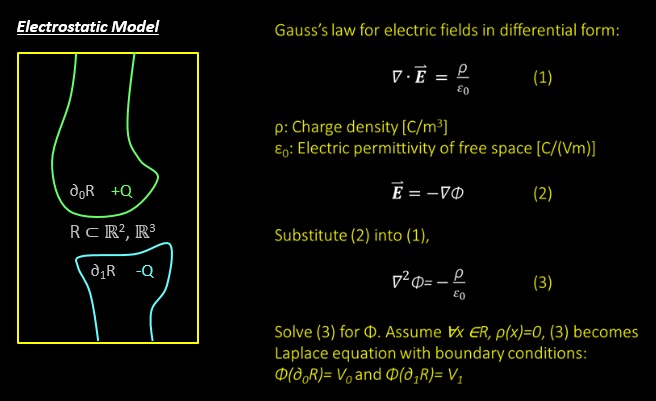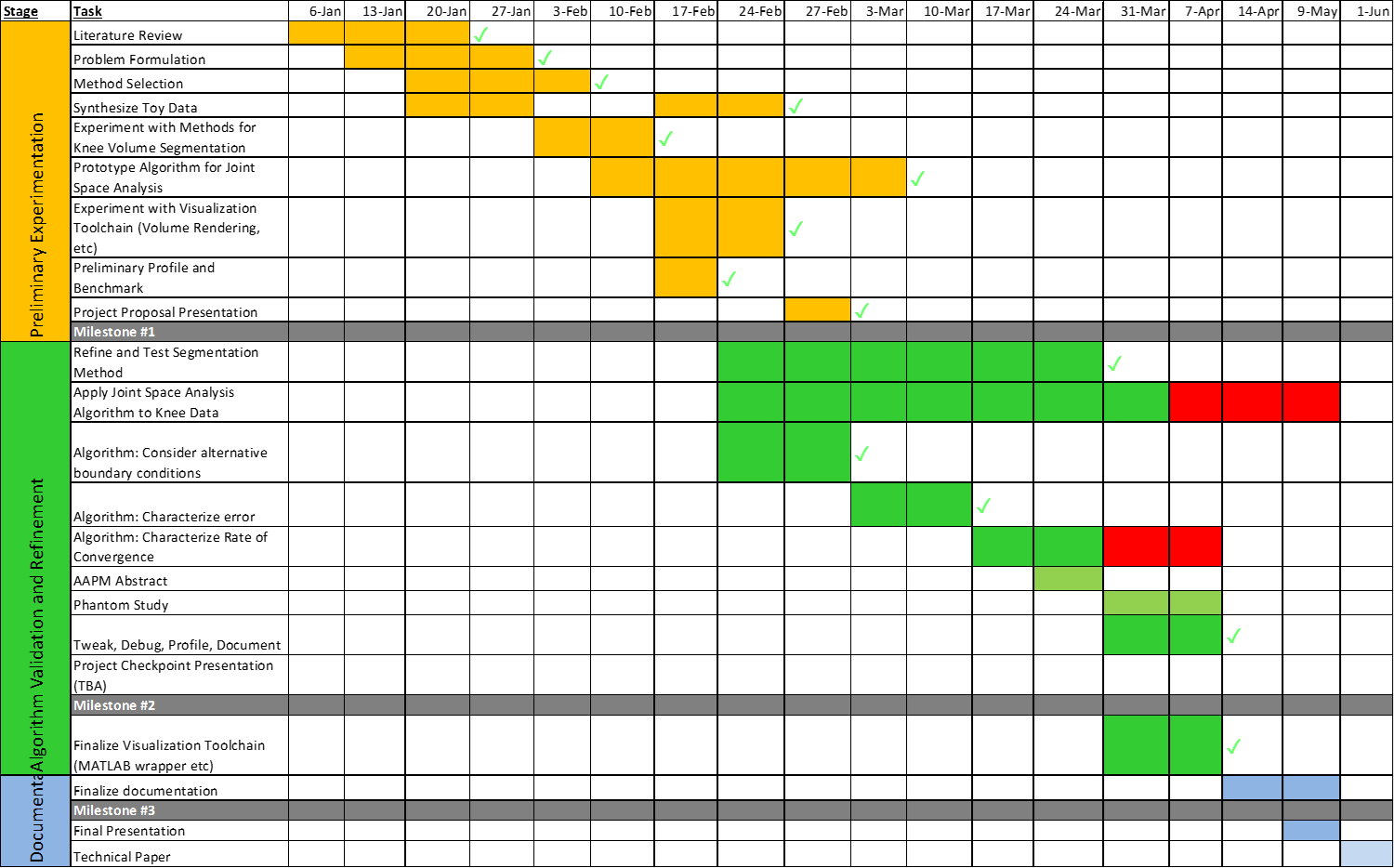Table of Contents
The Electrostatic Joint Space
Please allow the contents of this page to remain confidential until our technical paper is published (expected by 07/01/2014)
Last updated: 05/09/2014 Latest: Summary Report Uploaded
Summary
A capacitor model of the knee joint is developed to measure joint width in CT volumes. The implementation takes the form of a gpu-enabled MATLAB library.
- Student: Qian Cao
- Mentor: Prof. Jeffrey Siewerdsen
Background, Specific Aims, and Significance
Certain anatomical variations in knee morphology (e.g. tibial slope, etc) has recently been found to correlate with increased risk of injury resulting from load-bearing activities. This is significant for combat infantry personnel deployed abroad, who routinely carries a pack of up to 100 lbs while on active duty. In order to attempt to establish a valuable predictor of such risks, an efficient and accurate way of characterizing knee morphology from high quality CT data is needed. Joint space narrowing is also indicative of progression of diseases such as osteoarthritis, which affects nearly 27 million people in the US alone. The development of a robust method to detect such changes in joint space morphology is the primary aim of this project.
Goals:
- Develop and validate an algorithm for the analysis of knee joint morphology using the capacitor model.
- Test the algorithm on real CBCT knee data of osteoarthritic (OA) and non-OA scans (by comparing with clinical measures).
Deliverables
- Minimum: (Expected by 03/01/2014)
- A working set of prototype MATLAB functions for joint space analysis using the capacitor model. Also provide relevant documentation.
- Expected: (Expected by 05/01/2014 DELAYED See Milestones Section for updated schedule)
- A set of validated and bug-free MATLAB functions for joint space analysis using the capacitor model.
- Detailed in-line documentation of all code.
- Develop an efficient segmentation method to process CT data for analysis.
- Include a set of MATLAB routines for visualization of the analysis results (volume rendering + GUI) and provide documentation.
- Conduct a phantom study to compare the algorithm with existing closest-point method.
- Apply the analysis pipeline to the analysis of OA and non-OA knee joints under load-bearing (standing) vs non-load-bearing (sitting) conditions (62 CT Volumes).
- Maximum: (Expected by 06/01/2014 DELAYED See Milestones Section for updated schedule)
- Give a conference presentation and publish a paper on this topic.
Technical Approach
The laws of physics gives an elegant solution to the problem in the form of Maxwell's equations. The femoral and tibial surfaces can be modeled as two surfaces of a capacitor each applied with a positive and negative voltage, respectively.

Dependencies
All dependencies are met.
- Access to Prof. Siewerdsen. (Met at least two times a week. ✓)
- Access to knee volume data. (Two data sets available for testing. ✓)
- Access to relevant literature (JHU Library. ✓)
- Access to computing resources.
- Up-to-date MATLAB w/ image processing & parallel computing toolboxes (R2013b ✓)
- CUDA-enabled graphics card (NVidia GTX470 ✓)
- C++ IDE & compiler (Visual Studio 2008 ✓)
- Visualization library (VTK ✓)
- CBCT knee volume test data (Two 61 datasets of OA knees and non-OA knees available for algorithm testing and validation ✓).
- Phantom study.
- Equipment + materials + access to shop (Traylor machine shop ✓).
- Access to CBCT scanner (lab bench ✓).
- Radiation safety training (radiation badge acquired ✓).
Milestones and Status
- Milestone name: Prototype algorithm.
- Planned Date: 03/01/2014
- Expected Date: 03/01/2014
- Status: 100%
- Milestone name: Algorithm validation, documentation and application.
- Planned Date: 05/01/2014
- Expected Date: 06/01/2014
- Status: 80%
- Milestone name: Abstract and Paper
- Planned Date: 06/01/2014
- Expected Date: 07/01/2014
- Status: 20%
Reports and presentations
- Project Plan
- Project Background Reading
- See Bibliography below for links.
- Project Checkpoints
- Paper Seminar
- Project Final Presentation
- Project Final Report
Project Bibliography
* here list references and reading material
[1] J. R. Giffin, T. M. Vogrin, T. Zantop, S. Woo, and C. D. Harner, “Effects of Increasing Tibial Slope on the Biomechanics of the Knee,” Am. J. Sports Med. 32(2): 376-382 (2004).
[2] J. Hashemi, N. Chandrashekar, B. Gill, B. D. Beynnon, J. R. Slauterbeck, R. C. Schutt Jr., H. Mansouri, and E. Dabezies, “The Geometry of the Tibial Plateau and Its Influence on the Biomechanics of the Tibiofemoral Joint,” J. Bone and Joint Surg. 90: 2724-2734 (2008).
[3] J. Hashemi, N. Chandrashekar, H. Mansouri, B. Gill, J. R. Slauterbeck, R. C. Schutt Jr., E. Dabezies, and B. D. Beynnon, “Shallow Medial Tibial Plateau and Steep Medial and Lateral Tibial Slopes : New Risk Factors for Anterior Cruciate Ligament Injuries,” Am. J. Sports. Med. 38: 54-52 (2010).
[4] S. G. McLean, S. M. Lucey, S. Rohrer, and C. Brandon, “Knee joint anatomy predicts high-risk in vivo dynamic landing knee biomechanics,”Clin. Biomech. (2010) (in press doi:10.1016/j.clinbiomech.2010.06.002).
[5] K. B. Shelburne,H.-J. Kim, W. I. Sterett, and M. G. Pandy, “Effect of Posterior Tibial Slope on Knee Biomechanics during Functional Activity,” Orth. Res. Soc. Feb. 223-231 (2011).
[6] S. J. Shultz and R. J. Schmitz, “Tibial Plateau Geometry Influences Lower Extremity Biomechanics During Landing,” Am. J. Sports Med. 40(9): 2029-2036 (2012).
[7] W. Zbijewski, P. De Jean, P. Prakash, Y. Ding, J. W. Stayman, N. Packard, R. Senn, D. Yang, J. Yorkston, A. Machado, J. A. Carrino, and J. H. Siewerdsen, “A dedicated cone-beam CT system for musculoskeletal extremities imaging: Design, optimization, and initial performance characterization,” Med. Phys. 38(8): 4700 - 4713 (2011).
[8] A. Muhit, S. Arora, M. Ogawa, W. Zbijewski, J. W. Stayman, G. Thawait, N. Packard, R. Senn, D. Yang, J. Yorkston, C. Bingham, K. Means, J. A. Carrino, and J. H. Siewerdsen, “Peripheral Quantitative CT (pQCT) Using a Dedicated Extremity Cone-Beam CT Scanner,” SPIE Proc. Medical Imaging 2013, Orlando FL.
[9] Yezzi, A. J., & Prince, J. L. (2003). An Eulerian PDE approach for computing tissue thickness. IEEE Transactions on Medical Imaging, 22(10), 1332–9. doi:10.1109/TMI.2003.817775
Other Resources and Project Files
Source files are stored on lab servers and are backed up daily. They are available upon request (qcao@jhmi.edu).



